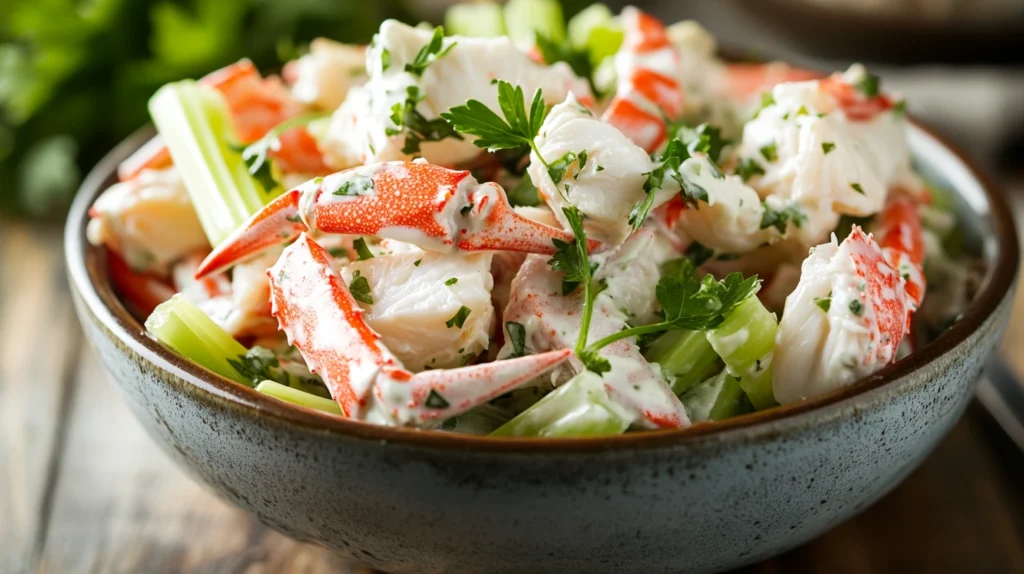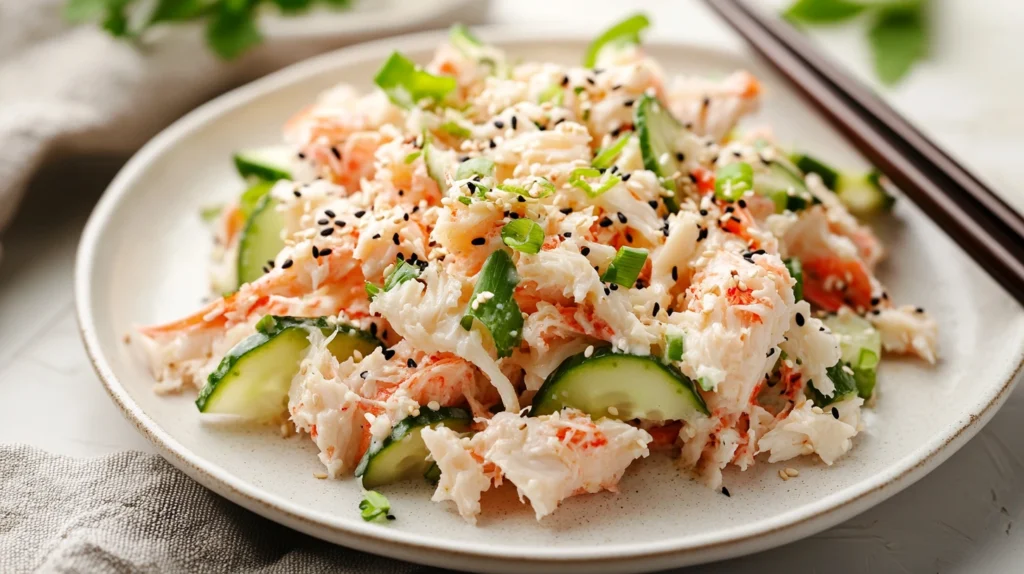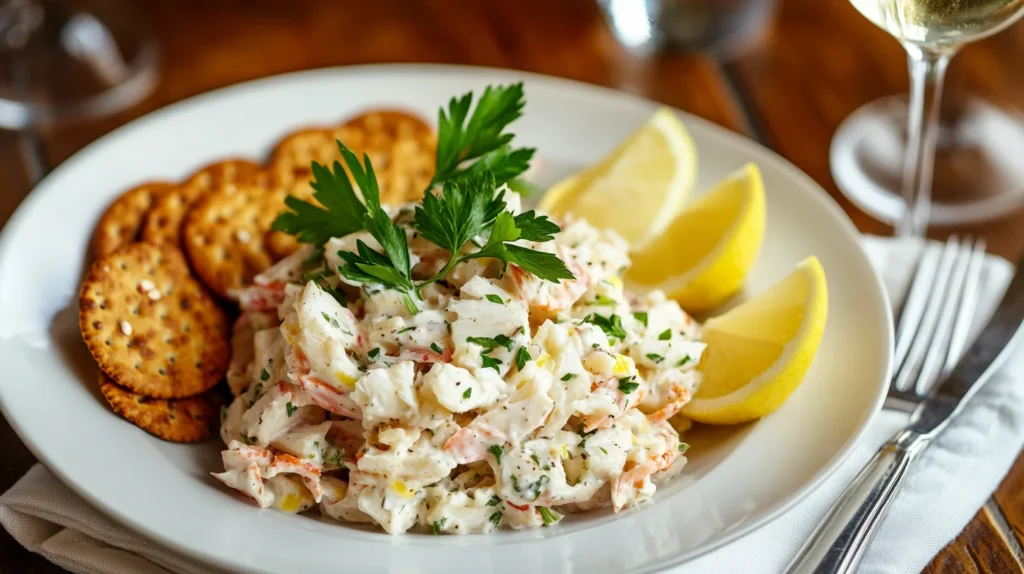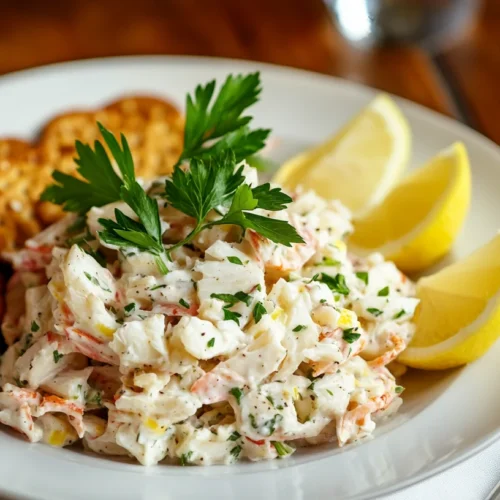Crab salad is a dish loved around the world for its great taste, flexibility, and health benefits. This easy-to-make recipe combines the sweet flavor of crab meat with fresh vegetables, creamy dressings, and tasty spices to create a meal that’s both delicious and healthy. Whether enjoyed as a starter, a main dish, or on crackers or sandwiches, it offers endless options.
In this article, we’ll share all you need to know about this seafood favorite. From its history and health perks to simple tips for making it your own, this guide will help you add crab salad to your regular meals. Get ready to learn and enjoy this classic dish!

What is Crab Salad?
Origin and History
Crab salad has a long and rich history, starting in coastal areas where crab was easy to find and widely eaten. It likely began as a simple way to use fresh seafood in a tasty and flexible dish. Over time, the recipe changed, adding ingredients and cooking styles from different cultures. From Japan’s love of seafood to the Mediterranean’s focus on fresh, light meals, this salad has become a favorite around the world.
This seafood dish is easy to adapt to local ingredients and tastes. In the United States, for example, it became a hit at summer picnics and holiday parties, often made with mayonnaise, celery, onions, and spices. Its simple nature and delicious flavor have made it popular in many types of cooking.
Traditional Recipes Around the World
Crab salad is celebrated globally, with each region adding its own twist:
- Japan: Incorporates crab into sushi rolls, pairing it with cucumber, avocado, and tangy sauces.
- Mediterranean: Combines fresh crab meat with olive oil, lemon juice, parsley, and vegetables for a lighter version.
- United States: Features a creamy dressing made with mayonnaise or sour cream, along with crunchy vegetables.
- Caribbean: Adds a tropical flair by including mango, coconut milk, or lime juice for a zesty, refreshing twist.
These variations highlight the global appeal of crab salad, showcasing its ability to adapt while maintaining its core essence.
Variations
Crab salad is one of the most versatile dishes, with endless possibilities for customization. Here are some popular variations:
- Classic Crab Salad: Combines crab meat with mayonnaise, celery, and seasoning.
- Spicy Crab Salad: Includes chili peppers or hot sauce for a kick of heat.
- Seafood Medley Salad: Mixes crab with other seafood like shrimp or scallops.
- Vegetarian Crab Salad: Uses imitation crab made from plant-based ingredients, catering to vegetarians.
- Avocado-Stuffed Crab Salad: Serves the salad inside avocado halves for a healthy and visually appealing option.
These variations ensure that there is a crab salad for every palate, whether you prefer creamy textures, bold spices, or fresh and tangy flavors.
Nutritional Benefits
Key Nutrients in Crab Meat
Crab meat is not only delicious but also packed with essential nutrients that make it a healthy choice for any meal.
- High-Quality Protein: Crab is an excellent source of lean protein, which helps build and repair muscles.
- Omega-3 Fatty Acids: These healthy fats support heart health, reduce inflammation, and improve brain function.
- Vitamins and Minerals: Crab meat is rich in vitamin B12, zinc, copper, and selenium. These nutrients aid in energy production, immune system function, and maintaining strong bones and tissues.
- Low in Calories and Fat: Fresh crab meat is naturally low in calories and fat, making it an ideal choice for those watching their weight.
These nutritional properties make crab meat an excellent ingredient for a balanced diet, especially when incorporated into a salad loaded with vegetables.
Benefits of Ingredients Like Vegetables and Dressing
A well-made crab salad goes beyond crab meat to include other nutrient-rich ingredients:
- Vegetables: Adding fresh veggies like celery, lettuce, cucumbers, or bell peppers boosts fiber, which helps with digestion and keeps you feeling full. These vegetables are also packed with vitamins A and C, which strengthen your immune system and keep your skin healthy.
- Dressing: Traditional mayonnaise dressings are creamy, but you can swap them with Greek yogurt or avocado for a healthier choice. These options are lower in fat and calories while adding important nutrients like potassium and probiotics.
By combining crab meat with a variety of nutritious ingredients, crab salad becomes a meal that satisfies both the palate and the body.
Health Benefits and Dietary Considerations
Crab salad offers a range of health benefits, including:
- Heart Health: Omega-3 fatty acids in crab help lower blood pressure and reduce the risk of heart disease.
- Weight Management: With its low-calorie profile, crab salad is an excellent option for weight-conscious individuals.
- Support for Bone Health: The calcium and phosphorus in crab meat strengthen bones and teeth.
- Brain Function: Nutrients like vitamin B12 and omega-3 fatty acids enhance cognitive function and memory.
Dietary Considerations: For individuals with specific dietary needs, crab salad can be easily adjusted:
- Low-Fat Diets: Use low-fat or fat-free dressings to reduce calorie intake.
- Keto Diets: Focus on crab, avocado, and low-carb vegetables to make the dish keto-friendly.
- Allergies: Substitute imitation crab for those allergic to shellfish but always verify the ingredients to ensure safety.
Crab salad offers a nutrient-dense, adaptable meal that fits various lifestyles and health goals.
Ingredients for Making Crab Salad
Essential Ingredients
To make a basic crab salad, you’ll need a few simple ingredients. These give the dish its flavor and texture:
- Crab Meat: Fresh, lump crab meat works best for its sweet taste. Imitation crab is a cheaper option.
- Vegetables: Celery, red onion, and bell peppers add crunch and freshness.
- Dressing: Mayonnaise is a classic choice for creaminess, but sour cream, Greek yogurt, or mashed avocado can work too.
- Seasonings: Add salt, pepper, and a little paprika or Old Bay seasoning for more flavor.
- Lemon Juice: A small splash of lemon juice makes the flavors pop and balances the creamy dressing.
Optional Add-Ons and Substitutions
Crab salad is incredibly versatile, and you can customize it with additional ingredients to suit your taste preferences. Here are some popular options:
- Herbs: Fresh parsley, dill, or chives provide a burst of freshness and aroma.
- Fruits: Diced mango, pineapple, or apple add a hint of sweetness.
- Proteins: Mix in shrimp or hard-boiled eggs for added protein.
- Dairy: Shredded cheese, like cheddar or Parmesan, can lend a creamy, salty note.
- Substitutions: If fresh crab isn’t available, imitation crab, canned crab, or even shrimp can be used as substitutes.
Tips for Selecting Fresh Crab Meat
To ensure your crab salad tastes its best, focus on selecting high-quality crab meat. Here are some tips:
- Fresh vs. Canned: Fresh crab meat has better flavor and texture, but canned crab is a cheaper and easier option. Choose brands that are lightly processed and packed in water or brine.
- Check for Freshness: If using fresh crab, it should smell clean and sweet, not fishy. The shells must be whole, and the meat firm.
- Imitation Crab Quality: If using imitation crab, pick one made from fish paste (surimi) that tastes and feels like real crab.
- Storage: Keep crab meat in the fridge and use it within one or two days for the best taste.
These ingredient tips and options will help you craft a crab salad that is both delicious and tailored to your liking.
Step-by-Step Recipe for the Perfect Crab Salad
Preparation of Ingredients
To ensure your crab salad comes together smoothly, start by preparing the ingredients:
- Crab Meat: If using fresh crab, cook and cool it before removing the meat from the shells. For imitation crab, simply shred or chop it into bite-sized pieces.
- Vegetables: Wash and dice celery, red onions, bell peppers, or any other vegetables you plan to include. Aim for uniform sizes to create a balanced texture.
- Dressing: Whisk together your dressing ingredients, such as mayonnaise, Greek yogurt, or sour cream. Add lemon juice, salt, pepper, and any desired seasonings like Old Bay or paprika.
- Optional Add-Ins: Prepare additional ingredients like herbs, fruits, or boiled eggs. Chop these finely to ensure they blend seamlessly into the salad.
Detailed Step-by-Step Instructions
Follow these steps to create the perfect crab salad:
- Combine the Base Ingredients:
- In a large bowl, mix the crab meat and chopped vegetables.
- Toss gently to avoid breaking up the crab meat too much.
- Prepare and Add the Dressing:
- Pour the dressing over the crab mixture, starting with a smaller amount and gradually adding more as needed.
- Gently fold the ingredients together until evenly coated.
- Incorporate Optional Ingredients:
- Add any additional ingredients, such as fresh herbs, diced fruits, or shredded cheese.
- Mix carefully to preserve the salad’s texture.
- Taste and Adjust Seasonings:
- Sample the salad and adjust the seasoning to your preference. Add a bit more salt, pepper, or lemon juice as needed.
- Chill and Serve:
- Serve chilled as a standalone dish, on crackers, or as a filling for sandwiches or wraps.
Presentation and Serving Tips
Making your crab salad visually appealing enhances the dining experience. Here are some presentation ideas:
- Plating: Serve the salad on a bed of lettuce or mixed greens for a vibrant and fresh look.
- Garnish: Sprinkle the top with chopped parsley, dill, or a dash of paprika for a pop of color.
- Portioning: Use small bowls or ramekins to serve individual portions, or scoop the salad into avocado halves for a unique presentation.
- Accompaniments: Pair the salad with crackers, toasted bread, or cucumber slices for a satisfying crunch.
With these steps and tips, you’ll create a crab salad that’s not only delicious but also beautifully presented.
Variations and Twists on Classic Crab Salad

Asian-Inspired Crab Salad
Asian flavors can elevate crab salad to a whole new level. Here’s how to create a vibrant, umami-rich variation:
- Ingredients:
- Crab meat, shredded
- Thinly sliced cucumbers
- Julienne carrots
- Sesame oil and rice vinegar
- Soy sauce or tamari
- Fresh cilantro and sesame seeds
- Preparation: Mix the crab meat with the vegetables. Add a dressing made of sesame oil, rice vinegar, soy sauce, and a little honey or chili paste. Top with cilantro and sesame seeds for extra flavor.
- Serving Idea: Serve as a salad or wrapped in seaweed for a sushi-style twist.
Mediterranean-Style
A Mediterranean take on crab salad emphasizes light, fresh ingredients with a tangy twist:
- Ingredients:
- Crab meat
- Cherry tomatoes, halved
- Kalamata olives, pitted and sliced
- Cucumbers, diced
- Red onions, thinly sliced
- Olive oil and lemon juice dressing
- Fresh oregano or parsley
- Preparation: Combine the crab meat and vegetables in a large bowl. Whisk together olive oil, lemon juice, minced garlic, and a pinch of salt and pepper, then toss with the salad.
- Serving Idea: Plate over arugula or spinach for a refreshing and healthy meal.
Low-Calorie or Keto-Friendly
For those watching their carb intake or counting calories, this variation focuses on healthy fats and low-carb ingredients:
- Ingredients:
- Lump crab meat
- Avocado, diced
- Diced cucumber and celery
- Lemon juice and olive oil or a keto-friendly mayo
- Dill and chives for garnish
- Preparation: Combine all ingredients in a bowl and gently mix. Use avocado as a creamy substitute for traditional dressings.
- Serving Idea: Serve in lettuce cups or on its own for a light yet satisfying meal.
Creative Twists
If you’re feeling adventurous, experiment with these unique ideas:
- Tropical Crab Salad: Add diced pineapple, coconut flakes, and a splash of lime juice for a Caribbean vibe.
- Spicy Southwest Crab Salad: Incorporate jalapeños, corn, black beans, and a smoky chipotle dressing for a bold kick.
- Crab Pasta Salad: Toss crab salad with cooked pasta, such as fusilli or bowtie, for a hearty version perfect for potlucks.
These variations and creative twists ensure that crab salad remains exciting, versatile, and adaptable to every taste and occasion.
Pairing Crab Salad with Other Dishes
Best Accompaniments
Crab salad is a versatile dish that pairs beautifully with a variety of sides and accompaniments. Here are some popular choices to elevate your meal:
- Fresh Bread: Serve crab salad with crusty baguettes, sourdough bread, or soft dinner rolls for a satisfying contrast of textures.
- Crackers: Opt for buttery crackers or whole-grain varieties as a light and crunchy pairing.
- Greens: Complement the richness of crab salad by serving it over a bed of arugula, spinach, or mixed greens.
- Grilled Vegetables: As a side dish, grilled zucchini, asparagus, or bell peppers add a smoky depth of flavor.
- Fruit Salad: A refreshing bowl of seasonal fruits like watermelon, berries, or mango provides a sweet counterbalance.
Beverage Pairings
Selecting the right beverage enhances the dining experience. Here are some recommendations to pair with crab salad:
- White Wine: A crisp Sauvignon Blanc or Chardonnay highlights the delicate flavors of crab.
- Sparkling Water: Infused with lemon or cucumber, sparkling water is a refreshing non-alcoholic option.
- Beer: A light lager or wheat beer complements the richness of crab salad without overpowering it.
- Iced Tea: Herbal or lightly sweetened iced teas make for a cooling and versatile drink choice.
Serving Suggestions for Special Occasions

Crab salad can be dressed up or down, making it suitable for various occasions:
- Appetizer: Serve small portions in martini glasses or endive leaves for an elegant start to a meal.
- Main Course: Offer larger servings alongside a hearty side, such as roasted potatoes or quinoa.
- Buffet Table: Present the salad in a decorative bowl with a selection of crackers, bread, and toppings for a self-serve option.
- Picnic or Outdoor Gathering: Pack crab salad into individual containers and pair with fresh fruit and chilled drinks for an easy-to-enjoy picnic treat.
Whether served at a casual gathering or a formal dinner, crab salad’s adaptability makes it a star dish on any table.
Related Recipes to Explore
- Looking for another seafood recipe? Try the Salmon Cakes Recipe for a crispy and flavorful delight.
- For an easy appetizer, these Barbecue Shrimp are bold and delicious.
- Need more seafood options? Explore the Fish Food Recipe for creative ideas.
Frequently Asked Questions
How many days can you keep crab salad in the refrigerator?
It can stay fresh in the fridge for 1 to 2 days if kept in a sealed container. Keep it safe by putting it in the fridge right after making it and not leaving it out too long. Before eating leftovers, look for signs it has gone bad, like a bad smell, slimy texture, or changes in color.
What is a good side for crab salad?
Here are some great options:
- Fresh Bread or Crackers: Crusty bread, croissants, or buttery crackers complement the creaminess of crab salad.
- Grilled Vegetables: Zucchini, asparagus, or bell peppers provide a smoky and fresh counterbalance.
- Greens: A simple mixed green salad or arugula dressed with lemon vinaigrette is light and refreshing.
- Rice or Quinoa: A small serving of seasoned rice or quinoa adds heartiness to the meal.
- Fruit Salad: Sweet fruits like watermelon, mango, or pineapple balance the savory flavors of crab salad.
These options ensure a satisfying, well-rounded dining experience.
Is crab salad healthy for you?
Yes, crab salad can be a healthy choice when prepared with the right ingredients. Here’s why:
- Crab Meat: Rich in protein, omega-3 fatty acids, and essential vitamins like B12, crab meat supports muscle health, brain function, and heart health.
- Vegetables: Ingredients like celery, cucumbers, and bell peppers add fiber, vitamins, and antioxidants.
- Dressings: Using low-fat alternatives like Greek yogurt or avocado instead of traditional mayonnaise can lower the fat and calorie content.
However, it’s important to watch portion sizes and avoid excess sodium or calorie-dense dressings to maximize its health benefits.
What is the history of crab salad?
Crab salad has a rich culinary history rooted in coastal regions where fresh crab was abundant. It likely originated as a way to use this delicacy in a simple, versatile dish. Over time, it evolved to reflect the culinary traditions of various regions:
- United States: Often featured in summer picnics, it became popular with creamy dressings and crunchy vegetables.
- Asia: Inspired variations like sushi-style crab salad emphasize fresh, tangy flavors.
- Mediterranean: Light versions use olive oil, lemon juice, and fresh herbs.
This global evolution showcases the adaptability of crab salad, making it a beloved dish worldwide.
Conclusion
Crab salad mixes the sweet taste of seafood with the crunch of fresh vegetables and the smoothness of a creamy dressing. This easy-to-make dish comes in many styles, making it perfect for light meals or fancy appetizers.
With its healthy ingredients, quick preparation, and great pairing options, this recipe is a must-try. Whether you’re a skilled cook or just starting out, learning how to make this dish gives you a reliable option for gatherings or daily meals. Enjoy the tasty mix of flavors and textures that make it a crowd-pleaser.

Classic & Creamy Crab Salad Recipe
Equipment
- Large mixing bowl
- Cutting board
- Sharp knife
- Measuring cups and spoons
- Mixing spoon or spatula
Ingredients
- For the Crab Salad:
- 1 lb 450g lump crab meat (or imitation crab)
- ½ cup celery finely diced
- ¼ cup red onion finely chopped
- 2 tbsp fresh dill chopped (or parsley)
- For the Dressing:
- ½ cup mayonnaise
- 1 tbsp Dijon mustard
- 1 tbsp fresh lemon juice
- ½ tsp Old Bay seasoning or paprika
- ½ tsp salt adjust to taste
- ¼ tsp black pepper
- ¼ tsp red pepper flakes optional, for spice
- For Garnishing Optional:
- Extra dill or parsley
- Lemon wedges
- Crushed crackers or toasted bread
Instructions
- Step 1: Prepare the Ingredients
- Drain and pat dry the crab meat to remove excess moisture.
- Finely chop the celery, red onion, and fresh dill.
- Step 2: Make the Dressing
- In a large mixing bowl, whisk together mayonnaise, Dijon mustard, lemon juice, Old Bay seasoning, salt, and black pepper until well combined.
- Step 3: Mix the Salad
- Add the crab meat, celery, red onion, and dill to the dressing.
- Gently fold everything together until the crab is evenly coated.
- Step 4: Chill & Serve
- Let the crab salad chill in the fridge for at least 10 minutes to allow flavors to meld.
- Serve on crackers, inside an avocado, as a sandwich filling, or over lettuce leaves for a refreshing meal.
Notes
Make it Healthier: Substitute Greek yogurt for mayonnaise for a lighter version.
Extra Flavor: Add chopped cucumber, bell pepper, or a dash of hot sauce for variety.
Storage: Store in an airtight container in the fridge for up to 2 days.

